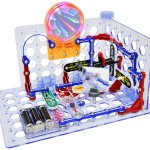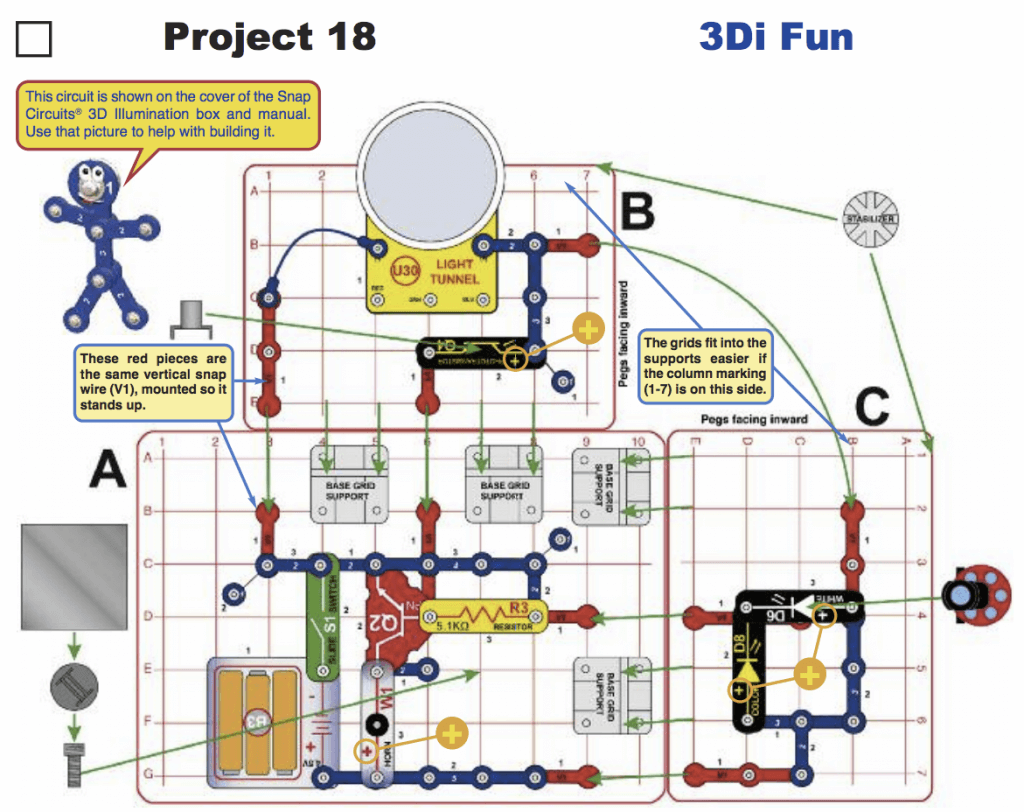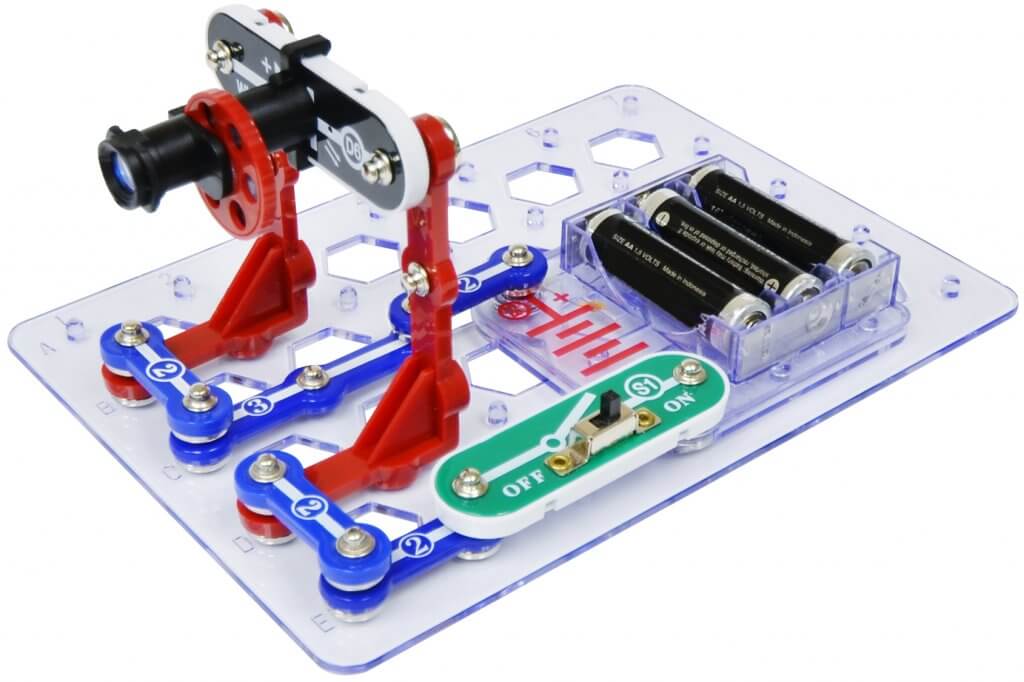QUICK STATS
8 years & up
Over 50 parts
45 minutes
Technology
Circuits/Electronics
Electronics
Building
Spatial orientation
Problem-Solving
Instructions PDF
Snap Circuits 3D Illumination is another brilliant entry in the Snap Circuits series that continues the line’s fun and educational experiments with electronics. This edition offers the chance to explore various light projects, including mirrors, projectors and light sensors. As part of the “3D” branch of Snap Circuits, young engineers will build their circuits upwards as well as on the traditional flat board. The kit is a useful addition even to homes that already have Snap Circuits sets, and it would make a fine beginner set if you’ve never used Snap Circuits before. Want to see numerical summary ratings? Skip to the conclusion for our detailed criteria breakdown and final review score.
What Are Snap Circuits?
 We bought the original Snap Circuits electronics project kit for my older two kids six years ago, and they still enjoy it. We were intrigued by the “gimmick” of easy-to-assemble circuits that didn’t require messy breadboards or tiny wires. It turned out to not be a gimmick at all; the snap-on connectors really worked and were perfect for my young children. Those funky snap connectors also turned out to be really rugged, even as the kids learned from and played with them for hours.
We bought the original Snap Circuits electronics project kit for my older two kids six years ago, and they still enjoy it. We were intrigued by the “gimmick” of easy-to-assemble circuits that didn’t require messy breadboards or tiny wires. It turned out to not be a gimmick at all; the snap-on connectors really worked and were perfect for my young children. Those funky snap connectors also turned out to be really rugged, even as the kids learned from and played with them for hours.
This particular version takes the snap paradigm a little further. By including special right-angle connectors and extra baseboards, your kid can build walls and snap circuits onto them. So far there are only two products in the 3D series: 3D Illumination and “3D M.E.G.” (the latter was just announced for the fall 2017 season). I hope that Elenco will add even more toys to this lineup soon!
What’s Included & How to Build Snap Circuits 3D Illumination
In the box you’ll find:
- 3D building boards onto which the circuits are snapped
- A variety of normal Snap Circuits electronics parts such as LEDs, resistors and switches
- A unique “light tunnel” that produces a cool effect through LEDs and a mirror
- A projector element that casts images from a wheeled disc
- Several other light elements, including mirrors and a photo transistor
- Instruction book with 159 projects
Snap Circuits, in general, are a cross between a building set and a science experiment kit. This 3D version takes the building aspect to include walls and then focuses (no pun intended) the experiments on light and color.
There are purportedly 159 total experiments, but don’t be overwhelmed because most of them are only minor alterations of a base project. There are around 30 truly “unique” base projects, which is still quite a few. The later ones get astoundingly complex, so don’t be worried when your youngster needs some adult guidance. There were a few places where the adults needed guidance too, but the instructions are really clear and the 3D illustrations are done amazingly well. So when difficultures arose, we got to utilize and develop problem-solving skills as we retraced our steps and examined where our model deviated from the book’s circuit diagram.
Choosing a favorite project was hard for my son, since he liked them all, but he narrowed down to the ones that use either the light tunnel or the projector, both of which are special pieces for this kit. He’s played a lot with LEDs and sounds in the Snap Circuits Extreme 750 kit we bought 6 years ago for the older kids, so I wasn’t surprised that he chose the new parts as his favorites.
Choosing a favorite project was hard for my son, since he liked them all . . .
The light tunnel is an interesting “infinity” mirror effect (and impossible to photograph, sorry!), but it doesn’t do a whole lot. My seven-year-old adores it, though, so I’m obviously not the target audience. I much prefer the experiments where you setup a mirror and use LEDs to shine on a sensor (phototransistor) and activate an alarm sound. These more traditional circuits were cool for my seven-year-old as well, but the tunnel and the projector (below) still won the day.

The projector was quite dim, but the small images it created using the wheel reminded me of the classic stereo viewer circular cards from my childhood. The instructions do tell you to darken the room for some of the experiments, so they acknowledge the brightness limitation.

Is Snap Circuits 3D Illumination fun and educational?
Snap Circuits toys are surprisingly fun, and this set is equal to or better than the rest. This is one toy that has kept the interest of all the kids, now including our third one. Number four, who is just four years old, will be ready when she gets a little better at reading. Right now she enjoys building with her older brothers and sister.
For educational value, I can hold up Snap Circuits as a great example of how to make a perfect STEM skills toy. You learn the solid theory of how circuits work, but all the messy prep work is taken care of because the correct components are assembled and ruggedized. In addition to electronics, this set teaches deep problem-solving skills as well; once you’ve made a single mistake, you then need to go back and test to find out what portion of the circuit is working correctly and where your misplaced connection is hiding.
More Rich Skills
Finally, this 3D version includes building skills as well. While it might seem trivial to add a wall or two, I can assure you that the set succeeds for one reason: it forces you to translate the written diagram and instructions into 3D space. You have to take the flat printed diagram and mentally manipulate it so that you can see how to route the plastic snap wires up and around corners. In my section on rich skills, I refer to this process as spatial orientation. It’s a skill your kids should master before they attempt STEM fields like engineering or artistic pursuits like sculpture.
Doing the transformations was quite challenging for both the kids and me as we adjusted to understanding what was going on, but we eventually settled in and could “see” the 3D image from the 2D diagram. The front picture on the box helps as well, so don’t get too concerned if you’re normally not a 3D thinker.
Complete Insanity and Time2Play
When you think of building sets, it’s pretty hard to deduct too many points on our Complete Insanity score because their very nature requires having tons of potentially lost pieces. Snap Circuits 3D does very well, though, because most of the pieces are pretty large, the maker provides a convenient website for ordering replacements, and they give you an organized (albeit thin and cheap) storage option via the original packaging. Overall we rate Snap Circuits 3D Illumination a 4 out of 5 on this important measure.
Each session can last for hours, but on the whole, we’ll assign an average Time2Play metric of 45 minutes, which includes picking up and putting away.
What ages of kids will enjoy Snap Circuits 3D Illumination?
Our DistribuFun histogram for Snap Circuits 3D Illumination lines up very well with the manufacturer’s recommendation of “8 years & up.” With parents’ help, some six-year-olds and most seven-year-olds will get a lot of enjoyment and knowledge from this kit.
I do have a quibble with the claim of “and up” when the product gives no upper age limit. There are two features that limit this product’s applicability to older teens and adults. First, it’s only expandable with other Snap Circuit parts. There’s no option for integrating a microcontroller, a fancy servo, or any non-Snap-Circuit components. You can’t build a real project with this like you can with an Arduino or Raspberry Pi kit. Second, the manual teaches little to no theory about why the circuit works. This is a huge drawback for older kids who are taking an electronics class. I love Snap Circuits because it got my younger ones interested in “real” electronics, but it’s quite limited in the amount that can be done outside of the narrow sandbox of those 159 projects.
For an alternative that does teach theory in an enjoyable, student-friendly way, consider a copy of the lengthy book Practical Electronics for Inventors. It’s got an extremely helpful and balanced blend of theory, instruction, and project ideas in a huge omnibus volume. Buy the fourth edition and it will add up to 1,056 pages as a paperback, which is a steal considering it’s less than $30.
Alternatives to Snap Circuits 3D Illumination that teach similar skills
Snap Circuits is the best game in town for these types of kits. You need to remember the toy’s limitations and supplement with books like the one I recommended above, but as a way to get kids excited about STEM skills, they are unparalleled. If you’re hesitant to start with one of the more expensive kits, consider the lowest cost version, which is usually less than $25. It’s been renamed over the years, but the current title is Snap Circuits Jr. SC-100. As the name implies, there are “only” 100 projects with this kit. The good news is that when you decide to upgrade, you can use these first components as extra pieces to extend your new kit since everything is compatible.
Other products to consider include a wide array of Arduino kits. Arduino is the name of a small microchip soldered onto a circuit board in such a way that other components can easily be attached. It’s the adult equivalent of Snap Circuits! (But don’t tell either group I compared them like that, yikes.)
My favorite version is made by an obscure little company in Shanghai called DFRobot. They send each kit with an organizer and a set of instruction cards that take you through increasingly complex “recipes” that show you how to use each part. There’s still not a lot of theory, but there is significantly more background and help than you’ll get elsewhere. Here’s the version I bought a year ago: DFRobot Starter Kit for Arduino with 15 Project Tutorials.
Value, durability, and longevity: Is Snap Circuits 3D Illumination a good buy?
At around $50, Snap Circuits 3D Illumination is a fair value. I wish it could be cheaper or include more components. The exotic light tunnel and projector (which I extolled above when I mentioned they were my son’s favorites) apparently drive up the price, as do the extra baseboards. But all these features do contribute to a great experience, so I can’t complain too much.
A standout feature of all the Snap Circuits sets is their durability and longevity. The parts won’t easily break, meaning that your budding young electrical engineer will be able to play with them for many years. When you consider obsolescence, some of the underlying circuit technologies haven’t changed significantly in 50 years, so it’s a fair bet this toy will last through your offspring’s childhood.
 Learn Richly Learning toys, educational games and STEM resources
Learn Richly Learning toys, educational games and STEM resources 
I’m looking for a first set for my almost 8 year old son. Do you think this 3d illumination set is a better option than the Lights Discovery Kit? https://www.amazon.com/dp/B008PEKYA4 Or possibly, wait for the 3d M.E.G. set to come out? Thanks for your help!
All the sets are unique, so it’s hard to choose a favorite. We liked the 3D illumination set because it introduced the building upwards, but now that the new M. E. G. is out, I’ll pick up one of those for Christmas. We don’t yet own the original Lights set, but I see that it has a flying propeller, which my kids ADORE from the Snap Circuits 750 set. Realize that wherever you start, it’s a lot like LEGO sets in that they are all compatible and you can keep expanding. Beware, you might end up with too many of these around the house ?